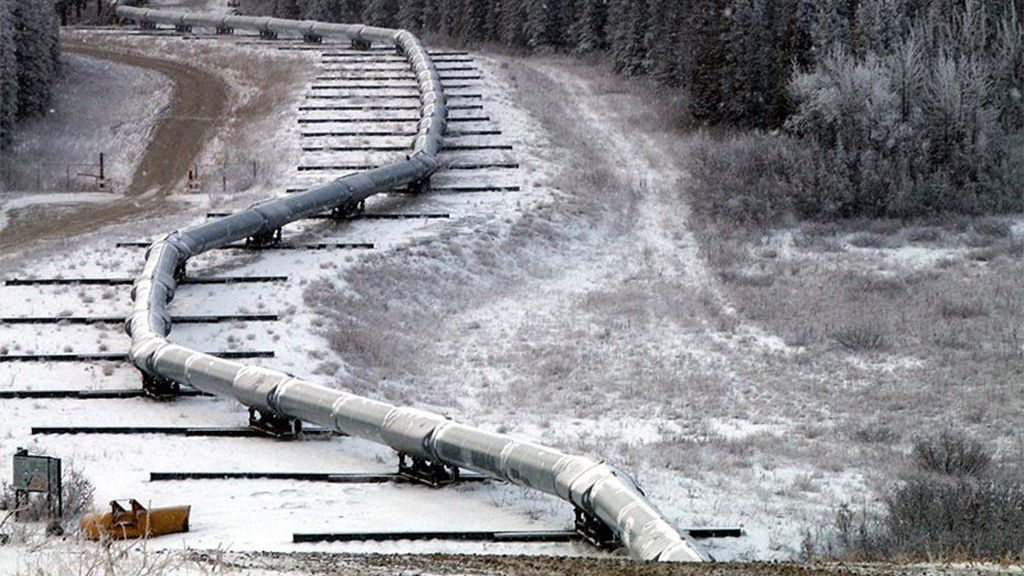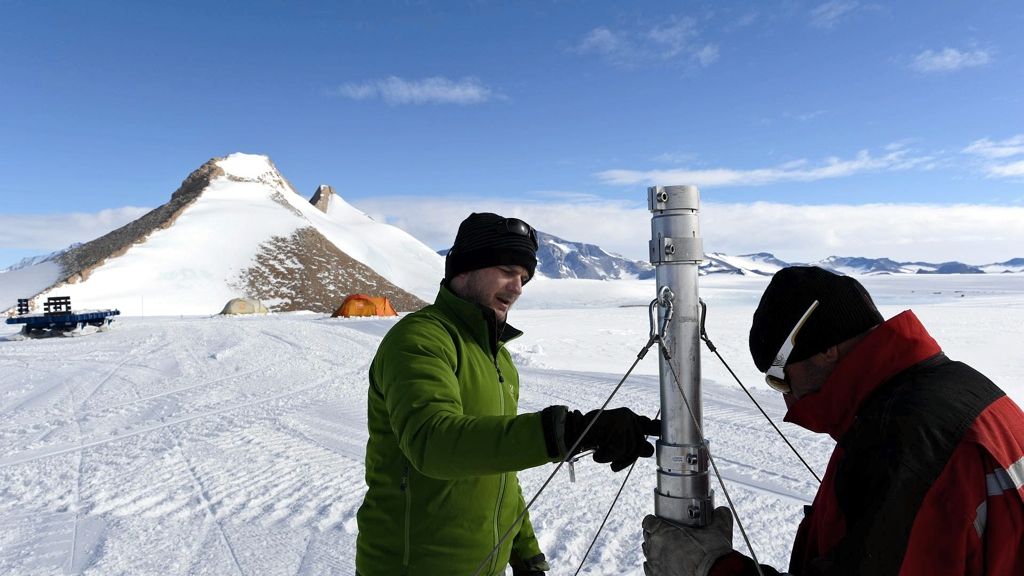How Arctic engineers are facing the challenges of a changing climate
Trans-Alaska Pipeline
© U.S. Geological Survey / U.S. Geological Survey
With average temperatures increasing, permafrost melting, and sea ice retreating, roads, bridges, buildings, and other structures are being affected right across the Arctic and sub-Arctic regions. Facing these challenges and the way structures need to be designed, constructed and maintained are Arctic engineers such as Dr. Orson Smith, professor of Civil Engineering at the University of Alaska Anchorage. Dr. Smith discusses some of the major issues Arctic engineers are facing, and the ways they are being addressed. He also emphasises the need to collect more climate data to better adapt new and existing structures to the changing climate.
How long has Arctic engineering as a specific academic discipline existed?
The construction of the Trans-Alaska Pipeline System (TAPS) in the late 1970s was the first time Arctic Engineering was really recognised as a specialty profession in its own right. Of course there had been much research and a lot of projects in the Arctic before that, but the 1970s was a time when development of oil, gas and other minerals in the Arctic was going on in great earnest, and engineering solutions were needed to manage these tasks in such a unique climate. After that, the discipline started to receive recognition as an academic programme and gain impetus in university programmes. A Master's-level degree in Arctic engineering or at least as a specialty track is available in most nations that have a strong presence in the poles such as the Scandinavian countries, Russia, Japan, South Korea, the US, Canada, and now even China.
What makes Arctic engineering unique as a discipline?
Our specialty deals particularly with regions where below-freezing temperatures regularly occur for months at a time; however the general principles we use in designing and constructing apply anywhere where freezing temperatures occur. We regularly deal with freeze-thaw effects on building materials or the exchange of moisture through walls of dwellings or office buildings. We also have to contend with the degradation of roadways and asphalt coverings. Essentially we handle all matters related to public safety vis-à-vis snow, ice, and below-freezing temperatures on a grand scale in places where these freeze-thaw effects can occur during any month of the year and happen more or less continuously six months out of the year. In developing means to avoid loss of function or avoid excessive degradation you need to use proper materials, proper design methods and proper construction methods to have something that can function and last in the unique Arctic environment.
What are the major issues you need to worry about as an Arctic engineer in light of climate change?
Firstly there's the issue of melting permafrost. In the Far North, permafrost, which is basically soil with ice particles mixed into its pores, is a pretty good foundation to build on as long as it stays frozen. But when it thaws and the ice in the pores of the soil turns to water, very often the remaining soil will no longer be able support heavy buildings, busy roadways, pipelines and so on. A lot of structures built on permafrost were designed with the notion that the permafrost would stay frozen. But now a large number of construction sites are being affected with the permafrost thawing.
There are also problems as a consequence of disappearing sea ice. The Arctic sea ice forms later in the year and recedes earlier in the spring, and in mid-winter it doesn't reach as far south as it has in the past. Because sea ice prevents wind from generating waves that can erode the shoreline, as it disappears you begin to see winter storms over open water generating waves that crash ashore and accelerate shoreline erosion in areas where indigenous communities are located. This is a major problem for them because a lot of these isolated, rural Arctic indigenous communities are situated in places that were chosen long ago as temporary places where they could hunt and fish. So they were never meant to support dramatically growing populations with 21st century amenities. As a consequence, these remote settlements tend to have a long list of problems, and erosion of their shorelines is one of the biggest problems.
Then there's the issue of having a greater number of freeze-thaw cycles as a result of the changing climate. Having fewer days with freezing temperatures may seem beneficial at first glance, but actually freeze-thaw cycles tend to be very destructive as they put more stress on materials. The more freeze-thaw cycles you have, the more your materials tend to degrade. This is not only true for buildings, but also for roadways. For example, anyone living in an area that experiences winter weather during any length of time during the year knows that potholes in asphalt roads form in the spring. This is due to the fact that the weather fluctuates from cold spring nights to warm spring days.
What are some of the solutions that have been proposed to deal with these problems?
In the case of permafrost, preventative design and construction measures are a key part of the any long-term solution. When choosing a site to build on, you want a place where the permafrost is less prone to settle once it thaws. This means building on sites with coarse-grained, sandy, gravely soil as opposed to areas near river deltas with peat moss or smaller-grained silty soil.
For structures already in existence, you need to monitor them closely. There are expedient measures you can take if one corner of a building begins to settle for example, such as building up the support under that corner to bring it back to being level. Most of the Trans-Alaskan Pipeline System was built on permafrost, supported by pilings driven into the ground. These pilings circulate heat out of the ground to keep it cold, even in winter. Yet as the climate changes across entire regions, these thermopiles aren't going to be as effective and large-scale re-routing of the pipeline is impractical. So the best solution is to carefully monitor the pipeline to see if its supports appear to be settling. If they do appear to be settling, they can either be raised, or you can construct new supports for the pipeline on more solid ground nearby. The Alaska Pipeline Service Company, which manages the pipeline, does a good job of keeping track of the pipeline's supports.
Likewise, the Alaska Department of Transportation and Public Facilities does a good job of monitoring state-owned roads, particularly in areas where settling is occurring chronically and dramatically. Roads are a little easier to re-locate and a lot of that kind of work is already being done where it's needed. But the best solution is to use a road foundation that's not affected by thawing. You need to choose your roadbed design carefully to keep heat from flowing into the permafrost below the road. If you do that then you just have to choose the right kind of asphalt mix and keep up with a regular maintenance programme to keep the road useable.
And how do you deal with coastal erosion and more frequent freeze-thaw cycles?
There numerous ongoing engineering efforts to control erosion along shorelines, and some methods work better than others. But it's a tough environment to work in. Not only do you have the ocean, which in itself is very cruel to the structures humans create, but you also have the Arctic climate, which is very destructive in its own right. So even with the best techniques available, in certain situations all you can so is buy time. For example if you've got a settlement on a very thin, sandy barrier island and the erosion that's occurring is such a large-scale geological event, the kinds of engineering solutions available can only have a limited effect. You might be able to control a small section of the shoreline for a decade or two maybe, and these solutions tend to be very expensive. In certain cases the only practical long-term solution might ultimately be for entire communities to relocate.
As for the greater number of freeze-thaw cycles, Arctic engineers already have a pretty good toolkit for dealing with this phenomenon. What the changing climate means for us in the Far North, however is that there's going to be less room for compromise since they're going to be happening more often. You'll have to be more careful in choosing the materials with which you build. This may at times mean using more expensive materials rather than settling for something less expensive and of lower quality.
Do changing weather patterns affect how you design, build and maintain structures?
Something you have to pay particular attention to in the Arctic and sub-Arctic is building across streams, constructing bridge openings and culverts. Precipitation patterns are altering drainage basins, and the altered drainage basins are changing the character of the sediment in streams and how it is transported. Many areas that used to get mostly snowfall throughout the year now get more rain instead, and more rain leads to the erosion of stream banks as well as ice jams and ice jam flooding. Bridge openings that had been designed for different climatic conditions now have to contend with coarser sediment brought in by more rain, which ends up clogging culverts, hindering the passage of fish, and causing even more flooding.
Engineers tend to rely on historical information when thinking of their designs. This isn't necessarily wise now that we know climate change is occurring. If you want to properly design a good water drainage system, for example, you need to know how much rain falls in a drainage basin and then relate that to the flow of the stream. A lot of regional weather patterns are changing as a result of climate change, so we need to have new measurements and new data in order to design bridges adapted to the new climatic conditions.
I imagine that there may be situations where you may not have much choice about where you can build. What do you do in these cases?
Some techniques to use are to build extra supports and factor into the design ways to alleviate settlement, so you need to design with the idea of in future years jacking up the structure because its supports have settled. One building that uses a similar design idea is the new German Neumayer and US South Pole stations in Antarctica, except there you don't have to contend with melting permafrost, just snow accumulation. The stations are designed to be continuously jacked up as snow builds up around them.
As for roadways, if massive settlement of the roadbed isn't occurring and you only have degradation of asphalt, it's actually less of a concern than one might think. If roadways degrade as a result of climate change and temperatures warm, it's happening on a scale of 10, 20, or even 30 years, which is longer than the usual lifetime of a roadway anyway.
Since when has the engineering community been discussing climate change as a major factor when designing structures in the Arctic?
A particular conference called the Warming World Conference we had here at the University of Alaska, Anchorage in January 2000 comes to mind. It was part of an annual conference series we have here at UAA and was sponsored in part by the US Arctic Research Commission. We dedicated the conference that year to how climate change is affecting the engineering profession, and it got a surprising amount of attention. That was one of the first meetings on the subject that I know of. So the discussions have been going on for the last eight and a half years or so.
How has this discussion evolved since then?
It's taken on a national and an international scope, and climate change has become a topic that is discussed regularly in conferences within the engineering community. I've attended some conferences in Washington, DC sponsored by the US Department of Transportation, which has created a specialised office to deal with climate change issues. The Arctic Climate Impact Assessment (ACIA) also included a major chapter on infrastructure, which is by definition an engineering issue.
What we don't have right now is sufficient climate data for certain regions. In order to design a structure well, you need to know the site conditions - what climatic conditions are like now and what they will be like during the life of your structure. This is a major issue that has been mentioned at every meeting I've been to on this topic. Until recently, there have been a few pitiful attempts to take measurements here and there. At least now some of the federal agencies that can help get us this data such as the National Ocean and Atmospheric Administration (NOAA) and the US Geological Survey (USGS) are realising the need to get this data, and have been picking up the pace and re-directing their efforts to get new climate data for us.
Professionally it's a nice common ground between engineers and scientists, because getting new data on the changing environment is really a scientific endeavour. I will say that it's imperative for environmental scientists to communicate their findings to engineers. Scientists tend to want to communicate only between themselves and maybe sometimes do some public outreach to school children or something like that. Unfortunately their colleagues in the sister profession of engineering are often overlooked, and that's something that needs to change.

Orson Smith
Orson Smith is a professor of Civil Engineering at University of Alaska Anchorage. He served as Department Chair (1/2006-5/2010) of the School of Engineering as well as Interim Dean (8/2011-4/2013). His resaerch interests focus on: coastal, port, harbor, ocean, and Arctic engineering; renewable energy; and climate change impacts on engineering works.





